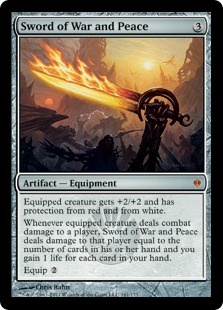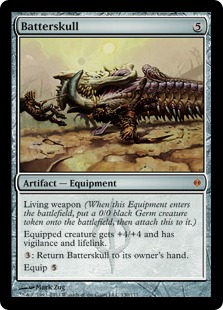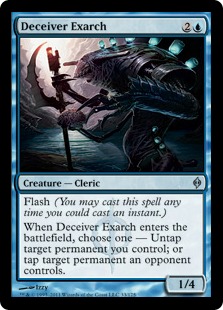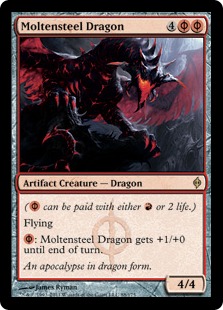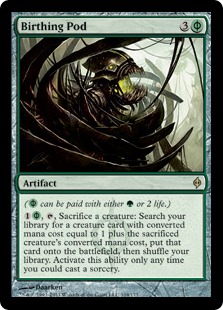Standard has one name, and one name only, at the top of almost every event in the last few weeks: Caw-Blade. I’ve written about it and recorded some
videos about it, and everyone and their little brother has lost to it. A lot. But why? Today, we’ll examine just what interactions make Caw Blade such
a dominant force, new cards to help fight it, as well as ways to break the mirror in your favor.
Over the last few weeks, I’ve heard countless friends lament the existence of Caw-Blade, saying things like “I hate playing the mirror.” They
continually complain that losing the die roll often ends in defeat. These people are stupid and/or wrong. Almost every single game is winnable through
selecting proper lines of play, as well as building your deck correctly. The players complaining about losing while on the draw probably could have
played a few more Condemns in their list or opted to play Tumble Magnet. They could have even saved that Spell Pierce for the opponent’s Gideon Jura
instead of the Preordain. Each game has a ton of decisions for you to make, but finding the best line of play is often convoluted and skill-intensive,
giving those who continually screw up a reason to whine and
giving the more experienced players the Trophy.
While the mirror is currently full of complex and difficult interactions, I’m a little afraid that this might change with New Phyrexia for one reason,
and one reason alone:
Sword of War and Peace will singlehandedly change the mirror, in a bad way, allowing for many more lopsided games if people don’t know how to adapt. It
makes all of your Squadron Hawks and Stoneforge Mystics on defense look pathetic, while preventing you from racing in the process. It will be a
significant reason to search up only one Squadron Hawk at a time in order to prevent massive damage, and possibly a reason to cut Condemn altogether.
Condemn has been a superb weapon in fighting against Sword of Feast and Famine but also doubles as the best removal spell you can ask for against
non-Fauna Shaman aggro decks.
You could potentially swap up your removal suite, playing more copies of Tumble Magnet and adding a few Dismembers for blowout potential, but it just
isn’t the same. You can’t afford to take four damage against a Boros deck in order to kill their Steppe Lynx. Condemn gave your deck an angle of
defense that was almost impossible for people to play around. If you had it, they would often just lose on the spot, since often they’d choose to run
into it, relying on your not having it. This would often put them in a very vulnerable spot. Equipping a Sword of Feast and Famine can be a little
dangerous, even in the first game, because it’s a huge commitment of mana that could give your opponent an opening to resolve Jace, the Mind Sculptor.
Without the fear of Condemn, the mirror will become drastically different, but people will be very slow to realize it.
While Condemn will likely get the axe from the deck, you’ll receive a new weapon against aggro that will be incredible difficult to beat if you play it
correctly.
Batterskull gives Caw-Blade a new Baneslayer-esque threat that’s more efficient, tutorable, and cheaper if you can sneak it into play with a Stoneforge
Mystic. This card alone will be reason enough for players to start packing more aggressive removal. You don’t want to allow your opponent to drop in a
Batterskull on the cheap with Stoneforge Mystic before you’re prepared to fight against it. Imagine this line of play against Boros, if you will:
Turn 1 Preordain.
Turn 2 Stoneforge Mystic.
Turn 3 Drop Batterskull into play off Stoneforge Mystic.
Turn 4 Drop Sword of War and Peace into play off Stoneforge Mystic, equip to Batterskull, and get to work.
While this won’t happen often, the threat of being able to do this against any red- or white-based deck is just absurd. This is equally true with Sword
of Feast and Famine against any green- or black-based aggressive deck. While Caw-Blade is already powerful enough without Batterskull, it’s an addition
that you’ll love, and it will make the deck a bit more consistent against your rougher aggro matchups. Both Equipment are sure to make an impact, so
expect both of them to be in the opponent’s deck if they’re packing Stoneforge Mystic. While people are hoping New Phyrexia will hold the key to
solving the format, it just might singlehandedly ruin it with these two newest additions for the format’s most popular (and powerful) deck.
While Valakut could be considered a “combo deck,” I find that I like Islands a bit more than Forests when it comes to “going off.” New Phyrexia gives
us a card that combos very well with Splinter Twin, and I can’t help but tingle when I think about this guy:
Deceiver Exarch is a creature that helps stall aggressive strategies but is also a way to make Splinter Twin a viable combo deck in Standard (and
Extended for that matter). With access to a free version of Peek in Gitaxian Probe to see if the coast is clear—as well as combo protection with
cards like Spell Pierce, Mana Leak, and Mental Misstep—you’re looking at a viable contender in Standard. Add to this the fact that it pairs
almost maliciously with Pyromancer Ascension—since both halves of the deck want to play an excessive amount of draw spells—and you’ve got
yourself a real powerhouse. I’ve seen a few awesome lists so far, and I’m working on one of my own, so don’t be surprised to see a few of these decks
cropping up in the Top 8 or Top 16 of the first StarCityGames.com Open when the set becomes legal.
Here is a potential list:
Creatures (4)
Lands (22)
Spells (34)
- 4 Lightning Bolt
- 4 Mana Leak
- 4 Burst Lightning
- 3 Into the Roil
- 4 Pyromancer Ascension
- 3 Splinter Twin
- 4 Preordain
- 4 Gitaxian Probe
- 4 Tezzeret's Gambit
Sideboard

The deck has a lot going for it, and it isn’t that easy to disrupt. Everyone is packing Crush and Divine Offering, ignoring enchantments. This could be
a prime opportunity for someone to take a tournament by storm. I’m generally in the business of giving people the business, and this deck is right up
my alley. You have all the tools to make it work, but finding the best combination of 75 cards is going to be quite difficult. A lot of choices you
need to make are based around what your opponent will likely be playing. If people begin to adopt the Dismember plan, that could mean bad things for
you. However, if they continue on with Condemn and Tumble Magnet, you should be just fine.
What does this deck mean for Caw-Blade?
Well, for starters, it means that cutting Condemn for Dismember might actually be the best option, even though it will be very painful against Boros
and Mono Red. What it also means is that you need to be a bit more aggressive with your sideboard cards. Celestial Purge is your best bet, hedging
against the Pyromancer Ascension and also killing the Splinter Twin in response to the first activated ability. It also doubles up against Mono Red,
and potentially Vampires, giving you a solid removal spell in the process. Cards that are generally good against combo and aggro tend to make for valid
sideboard slots. I’d recommend at least two, but I’d probably play three or four in an upcoming event, since this deck is getting a bit of hype.
Without Condemn, you’ll need a little more help against Bloodghast and Pals anyway.
With the Caw-Blade as is, chock full of worthless removal, I’m pretty sure Pyrotwin would be an awful matchup for Caw-Blade, especially so after
sideboarding. I feel like See Beyond is potentially viable as a means to shuffle away excess copies of Splinter Twin or Deceiver Exarch, giving you a
bit of breathing room while playing the two combos in such a small shell. However, doing so would require cutting down on burn spells or other draw
spells, making your Pyromancer Ascension plan much less viable if you choose the former, and making your aggro matchups much worse in the process.
Spell Pierce and Mana Leak are almost interchangeable between the maindeck and sideboard, and I’m not sure which one you’ll want more at the moment,
but we’ll start with Mana Leak for now while the format is in its infancy. Mana Leak helps answer annoyances like Stoneforge Mystic and opposing
Deceiver Exarchs and is generally better in an open format. Once the metagame settles, you can figure out which one is best. If you end up playing
Spell Pierce in the maindeck over Mana Leak, I might recommend playing Flashfreeze in the sideboard instead of Mana Leak to help out against Mono Red
and Valakut strategies.
Into the Roil is the current “catch-all” for the deck, giving you an incredible tempo boost against opposing Swords, as well as being an answer for the
mirror. Bouncing an active Pyromancer Ascension will almost always be backbreaking, and it even protects you from the Splinter Twin combo. I was
skeptical at first, but the card really earns its keep, occasionally drawing you a card in the process. With an active Pyromancer Ascension, it starts
to get silly.Â
Having access to Mental Misstep in the sideboard prevents people from being able to easily disrupt your combos with Duress, Despise, Dodecapod, and
every other card that begins with a “D.” What you have to realize is that it doesn’t really give you that much protection, and you shouldn’t always jam
four, since having too many counterspells might end up diluting your deck. There are other possible sideboarding options worth exploring, but I think
starting with Mental Misstep is fine. It’s great in matchups where Burst Lightning or Lightning Bolt become mediocre, and those matchups are where
you’ll want more counterspells to protect your Exarch or Ascension. Be wary because cutting burn usually means you’re all-in on Splinter Twin. If you
want to be sneaky, you can leave in your Burst Lightnings and a few Lightning Bolts just so you have the ability to kill them with burn if you suspect
shenanigans like Memoricide or Surgical Extraction (after having dealt with one of your Splinter Twins or Deceiver Exarchs).
I’ve seen a few lists running one or two Call to Minds, which doesn’t seem terrible, but I really hate having less than three copies of any instant or
sorcery in a Pyromancer Ascension deck, let alone having less than four. You’re already jamming 7-8 cards that don’t combo well with Pyromancer
Ascension in the form of your Splinter Twin Combo, so having fewer ways to trigger your Ascension seems mediocre at best. While it does give you the
ability to “go infinite” if you draw both with an active Pyromancer Ascension (and I’m using the term loosely, seeing as you don’t have Time Warp
anymore), you’ll rarely need it. Having an active Ascension is almost game over for any deck, just as long as you have a cantrip or two to tag along
with it.
If Caw-Blade continues to dominate and Tumble Magnet’s stock continues to rise in Standard due to the existence of so many amazing forms of Equipment,
where does that leave us? Decks that can abuse Tumble Magnet or have cards that tag along nicely—such as Venser, the Sojourner and Contagion
Clasp—will be primed for potentially strong showings. We already saw David Sharfman Top 8 the Standard Open in Atlanta with a Venser deck. With a
few new goodies coming to the table, the deck could become Caw-Blade’s worst nightmare.Â
One problem with this theory, however, is that people are going to start packing a lot more artifact hate to combat the Stoneforge Mystic decks,
simultaneously making Tumble Magnet a liability if you’re using it as a crutch. But, if you’re packing plenty of planeswalkers, I don’t think it’s
possible for you to have too many Tumble Magnets (and Contagion Clasps for that matter). I’ve been working on a Venser list lately but just haven’t
been able to come up with anything solid yet. All of my testing has been pre-NPH, so it’s quite difficult to gauge just how much of an impact it will
have. Caw-Blade is just the best deck before the release, and I have trouble playing a different deck when Caw-Blade is clearly so dominant.
The new set doesn’t become legal in tournament play for another week and a half, giving people plenty of time to come up with some interesting
technology. It will be fun to see what people try to brew up when they’re given access to over a hundred new cards. I’m excited to see what the new
format will bring, whether it be Grand Architect along with Myr Superion, or Assault Strobe with Immolating Souleater. In order to combat consistency,
you need explosiveness, and that’s exactly what Phyrexian mana brings to the table.
Phyrexian mana means a lot of things for Magic, but the best cards will be determined in time when people figure out just what it means to pay life
instead of mana. Paying life instead of mana generates an incredible amount of tempo, which is something Caw-Blade doesn’t normally produce a lot of.
They’re spending two mana for 1/1s and 1/2s, while you could be spending your mana to do broken things.
The way to beat Caw-Blade involves creating as much card advantage as they do, while also putting them at a board disadvantage. There are a lot of ways
to do this, but there’s just no reason to innovate when you can pilot the best deck yourself and dominate everyone. All the best players in the room
are playing Caw-Blade, and for good reason. There were a lot of ways to hate out Faeries, including a very rough Mono Red matchup. Caw-Blade has no
glaring weaknesses, but it isn’t “broken” in the traditional sense. It’s a card advantage engine that plays most of the best cards in Standard in a
tight little package.
A few weeks ago, people were clamoring for the head of Jace, the Mind Sculptor. What people don’t realize is that Jace isn’t the problem. Stoneforge
Mystic is easily the best card in the deck, and I’d argue that Jace isn’t even in the Top 5. Sure, he’s really important in the mirror, but you could
argue that he’s actually quite bad against a lot of the format’s aggressive decks. While he is the deck’s main means of raw card advantage, it’s the
Squadron Hawks and Spell Pierces that get you to the point where you can safely play him. While Jace is really good, he isn’t so good that he
deserves to be banned by any means.
Axing Jace would probably mean the end for control and what people also fail to realize is that without a viable control deck in the format, Valakut
decks would reign supreme. Primeval Titan is not that great by himself, but he’s a one-card combo with Valakut in the format. People have much less fun
playing against one-sided combo decks than they do against interactive control decks. It’s not like Caw-Blade is a prison control deck that keeps you
from casting your spells. They usually only play six counterspells, and three of them are Spell Pierce. Jam your creatures into play and turn them
sideways! Don’t be afraid to get hit with a Sword of Feast and Famine. Just discard a Vengevine, and punish them on your next turn! Â
Caw-Blade shouldn’t be the end. It should be the beginning. Find a way around it; find a way to fight through it; or find a way to trump it. New
Phyrexia will give you the tools to do so, and it’s truly up to you whether you use them or not. Happy brewing.Â
Thanks for reading.
Todd
strong sad on MOL

